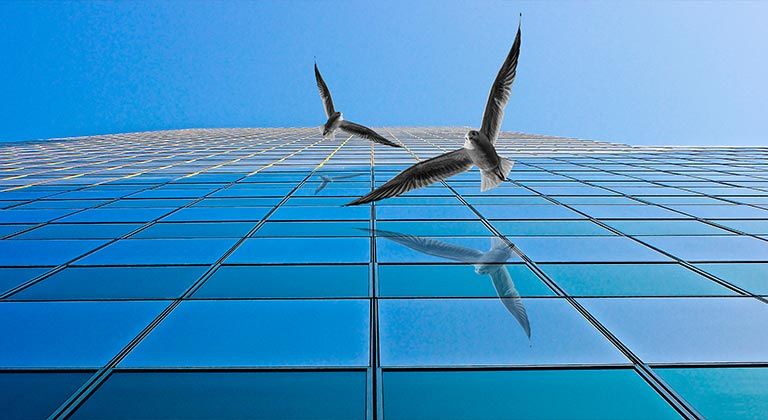
New construction often represents exciting growth and opportunity for the community. However, from a conservation standpoint, the construction of buildings, streets, and other developments can pose a threat to an area’s natural environment. Whether it’s a freeway that cuts through a mountain lion’s hunting grounds or dam that diverts water from a freshwater habitat, there are often real, disruptive consequences to construction projects, however unintended they might be.
One very common issue the glass and glazing segment of construction must contend with is the risk that reflective building materials pose to birds. According to the San Francisco Planning Department, extensive research has shown structural collision with windows and buildings to be the leading cause of death among wild birds in North America, accounting for anywhere between 100 million and one billion bird deaths each year.
The vast majority of these deaths occur along migration routes, where wild birds unfamiliar with urban landscapes and “exhausted from flight” must contend with man-made structures. California, in particular is an especially dangerous area since it is nearly 100% covered by two migration paths – the Pacific Oceanic Route and the Pacific Coast Route.
As a California company that provides glazing services to the construction industry, Giroux Glass is no stranger to this issue. Fortunately, there are many bird-safe architectural glass options on the market specifically designed to remedy this problem. Here’s a breakdown of some of the top bird-safe industrial glass brands, and how their unique technology is doing its part to protect our wildlife. All glass varieties featured on this list have been tested and approved for bird safety by the American Bird Conservancy.
Guardian Glass offers two options for bird-safe glass: a frit-patterned glass that breaks up reflective surfaces with a uniform dot pattern, preventing birds from seeing glass as an extension of the sky, and a newer Bird1st™ UV coated glass, which features a striped UV coating that’s very obvious to birds, but barely visible to the human eye.
Another patterned glass, Ornilux’s subtle cross-hatching is highly visible to birds, but only mildly visible to humans. This glass treatment also works well with a number of energy-efficient glass technologies, including Arnold Glas Low E or solar control coatings.
Bendheim’s channel glass allows for the construction of glass walls up to 23’ high and limitlessly long. While the glass itself is available in a wide range of textures and appearances – some reflective, some matte and translucent — the channels that hold the glass in place inherently break up the surface, rendering it bird-safe.
Perhaps the most transparent bird-safe glass on the market, this specialized glass is inset with ultra-violet stripes invisible to the naked human eye. Birds, however, are able to see the color differences. According to GlasPro, this glass “Significantly exceeds the American Bird Conservancy’s minimum standard for effective bird collision deterrent materials” with an avoidance index of 79%
Not only does Viracon® offer several varieties of bird-friendly glass products, they were at the forefront of their development. In fact, the company has been researching how patterns and other glass technologies can be used to reduce instances of bird strikes for over a decade. Their primary focus is testing and developing applications (screens) for conventional glass, which allow windows of all sorts to become safer for birds without relying on large-scale replacements and installations.
This etched glass comes in a wide array of elegant patterns, from horizontal and vertical stripes, to closely or widely spaced dots, to “organic” shapes. This glass is especially effective for birds because its patterns are etched directly into the surface of the glass, not applied as a coating, which can display glare in certain conditions.
These are just a handful of solutions that can help protect our feathered friends from potentially fatal glass collisions, and most of these glass brands cost the same as their non-protective counterparts at installation.
There are also plenty of options for retroactive ‘bird-proofing,’ including industrial-grade film application for large-scale projects and DIY film coatings for private use. Blinds, barriers, and other implements are also Check out all of the American Bird Conservancy’s suggestions here to see how you can help save avian lives.
Bring decades of experience to your next glass project
